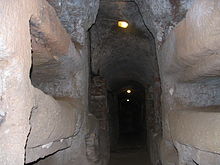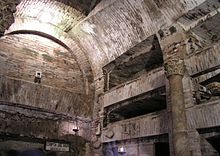Catacomb of Calixtus
The Calixtus Catacomb (also Callistus Catacomb , Italian Catacombe di San Callisto ) between Via Appia Antica , Via Ardeatina and Vicolo delle Sette Chiese is one of around sixty ancient underground grave systems in Rome. This Coemeterium Calixti ("resting place of Calixtus") was the first community catacomb of the Christians and is named after the bishop of Rome Calixtus I († 222), who was still entrusted with the administration of the whole complex as a deacon and who under his pontificate ( 217–222) expanded.
Building history
Before it was used by the Christians, pagan burial grounds extended along the Via Appia. The area probably comes from the private property of the Caecilier family . In the middle of the second century, the future catacomb passed into the direct administration of the Church. The catacomb, reserved for Christians, was subsequently created from several subsequently interconnected "regions", i. H. from smaller graves with corridors, chambers and vertical shafts for lighting and ventilation. It extends below an area of around 15 hectares, extends over four levels up to 20 m deep into the ground and has an underground extension of around 20 kilometers. There are an estimated 370,000 graves in the catacomb (through reuse, the number of burials is estimated at well over a million), the burial of around a hundred martyrs and sixteen bishops is recorded. As the first church burial site, but also because of the many important graves and wall paintings , the Catacomb of Calixtus is of particular importance.
From the fifth century onwards, burial above ground gradually replaced underground burial. However, the catacombs, with their graves of martyrs and saints, were popular as pilgrimage sites until the eighth century. In the second half of the fifth century a (but no longer preserved) basilica was built on the site. There were previously smaller mausoleums or halls, all of which were also missing except for two “tricora”, ie three-fold apse structures. Destructions in the Italian wars between Goths , Vandals and Oströmern but dilapidated and led to the endangered relics to the city churches transmitted . The underground tombs that were no longer needed were forgotten due to a lack of visibility, the entrances collapsed or were overgrown. Later the area was used for wine growing. It was not until 1844/49 that the archaeologist Giovanni Battista de Rossi found evidence of the location of the Calixtus catacomb, the existence of which was confirmed by excavations in 1852. A contiguous area of 34 hectares, the "Calixtus Complex" (where the underground cemeteries of Saints Soteris , Marcus , Marcellinus and Damasus, and Balbina are located), was bought up by the Holy See until 1920; Care was taken by Trappist monks from 1884 to 1936 , and since then by the Salesians of Don Bosco together with external staff. You have two branches on the site. Scientific support and research are carried out by the Pontifical Commission for Christian Archeology ( Pontificia Commissione di Archeologia Sacra ), formed in 1852 .
Popes' tombs
The first bishop of Rome whose grave can be documented is that of Zephyrinus (198-217) in the burial zone above the catacomb of Calixtus I. Urban I (222-235) was after the entry in the Liber Pontificalis in the catacomb buried and in the "Crypt of the Popes" rediscovered by de Rossi in 1854, the following popes were verifiably buried: Pontianus (230-235), Anterus (235-236), Fabianus (236-250), Lucius I (253-254 ), Stephan I (254–257), Dionysius (260–267), Felix I (269–274), and Eutychianus (274–282)
Parts of the catacomb
The oldest parts form the "region of the popes" with its crypt and that of the hll. Cecilia and Lucina from the second and early third centuries. The crypt of the popes, discovered in 1854, represents the historically most important and spiritually significant site of the catacomb. The room, which was created as a private burial chamber at the end of the second century, was redesigned as a crypt in the third century and, according to tradition, served as a burial place for nine popes (of five are still broken Grave slabs preserved) and eight other church dignitaries. In the fourth century, Pope Damasus I had the crypt expanded into a church service room with an altar, two light shafts, columns and architraves , of which only remains have been preserved. The neighboring crypt is named after St. Cecilia, whose body was transferred to the church of Santa Cecilia in Trastevere , which was consecrated to her in 821 . The room is decorated with mosaics and wall paintings, including a representation of Saint Cecilia in prayer position. A copy of the baroque statue of the saint by Stefano Maderno has been placed in a large niche . Finally, the “region of the popes” includes the sacrament chapels and five family burial chambers with frescoes on the sacraments of baptism and the Eucharist . The crypts of Lucina are named after a Roman woman who, according to the Liber Pontificalis, had Bishop Cornelius buried in a family grave that was separate until the fourth century. The grave slab of Cornelius, who was venerated as a martyr by the ancient Christians, which was found in the 1840s, made it possible to rediscover and identify the Lucina crypts and the entire Calixtus catacomb in general.
Further regions, each with many important crypts, are those of St. Miltiades (originated in the middle of the third century), Cajus and Eusebius (late third century), the western (first half of the fourth century) and the Liberian region (second half of the fourth century). These later facilities have some very large meeting rooms that could accommodate several dozen people for worship. During this time, the catacombs were increasingly laid out as complex systems of gallery corridors intersecting at right angles, the tombs were more elaborately furnished ( arcosolies instead of simple niches, columns and pilasters , barrel vaults and domed vaults); Last but not least, marble cladding and inscriptions were found for martyrs' graves that were expanded like chapels. The building of direct access shafts and stairs, such as the Lucina crypts, corresponded to the increasing rush of believers.
Photo finds

The picture finds and well over two thousand inscriptions in the catacomb are of particular importance. They give clues to the ancient living conditions as well as early Christian beliefs and rites. The first epigraphic evidence for addressing the Bishop of Rome as “Papa” (Pope) in connection with the tomb of Pope Damasus I is also found. There is also no lack of syncretistic ideas, the mythological phoenix appears as a symbol of Christ's resurrection , a ceiling painting shows in the Orphic revered Okeanos . The entire spectrum of the professional world is reflected in the epigraphs, which name the age of the deceased as well as their activities. In addition to the actual grave inscriptions, graffiti appears particularly frequently in the vicinity of martyrs' graves : visitors or miners working in the catacombs scratched their names or invocations of saints or loved ones into the plaster of the wall.
Web links
literature
- Antonio Baruffa: The Catacombs of San Callisto - History, Archeology, Faith. Publishing house Libreria Editrice Vaticana, Vatican City 1996, ISBN 88-209-2290-8 .
- Lucrezia Spera: Cal (l) isti coemeterium (via Appia). In: Adriano La Regina (Ed.): Lexicon topographicum urbis Romae: Suburbium . Volume 2. Rome 2004, pp. 32-44.
Individual evidence
- ↑ Bruno Moser (ed.): The papacy - epochs and shapes. Südwest Verlag, Munich, August 1986, ISBN 3517008095 , page 186.
Coordinates: 41 ° 51 ′ 32 " N , 12 ° 30 ′ 39.8" E




